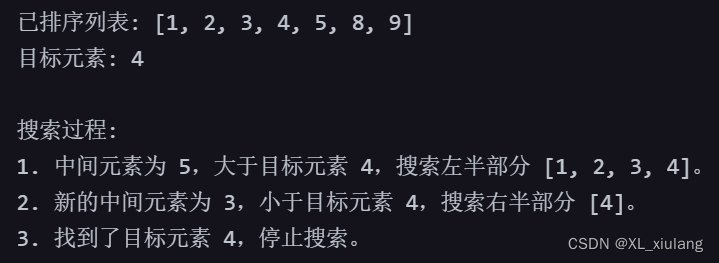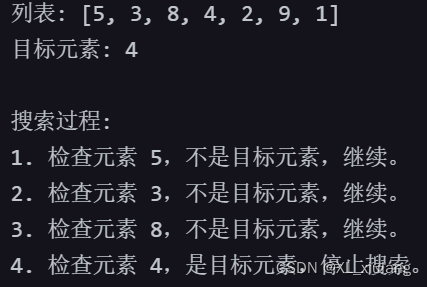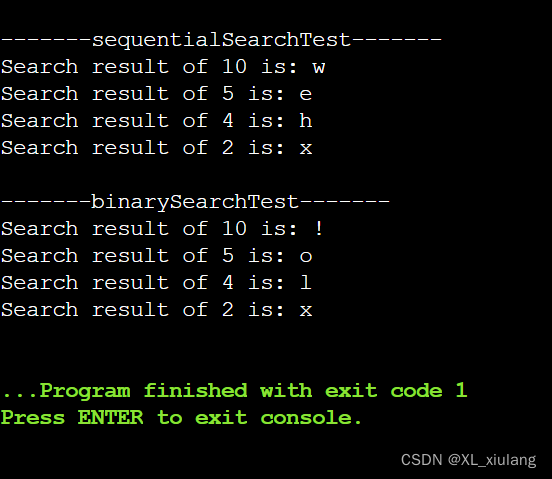一.代码
#include <stdio.h>
#include <malloc.h>
typedef struct Node{
int key;
char value;
}Node, *NodePtr;
typedef struct SequentialList{
int length;
NodePtr elements;
}SequentialList, *ListPtr;
ListPtr initList(int* paraKeys, char* paraValues, int paraLength){
int i;
ListPtr resultPtr = (ListPtr)malloc(sizeof(struct SequentialList));
resultPtr->length = paraLength;
resultPtr->elements = (NodePtr)malloc((paraLength + 1) * sizeof(struct Node));
for (i = 0; i < paraLength; i ++){
//printf("setting key for index %d: %d and value: %c\r\n", i, paraKeys[i], paraValues[i]);
resultPtr->elements[i + 1].key = paraKeys[i];
resultPtr->elements[i + 1].value = paraValues[i];
}
return resultPtr;
}
char sequentialSearch(ListPtr paraListPtr, int paraKey){
int i = paraListPtr->length;
paraListPtr->elements[0].key = paraKey;
paraListPtr->elements[0].value = 'x';
while(paraListPtr->elements[i].key != paraKey){
i--;
}
return paraListPtr->elements[i].value;
}
void sequentialSearchTest() {
int tempUnsortedKeys[] = { 4, 5, 3, 6, 10, 7, 1, 9 };
char tempContents[] = { 'h', 'e', 'l', 'o', 'w', 'r', 'd', '!' };
ListPtr tempListPtr = initList(tempUnsortedKeys, tempContents, 8);
printf("Search result of 10 is: %c\r\n", sequentialSearch(tempListPtr, 10));
printf("Search result of 5 is: %c\r\n", sequentialSearch(tempListPtr, 5));
printf("Search result of 4 is: %c\r\n", sequentialSearch(tempListPtr, 4));
printf("Search result of 2 is: %c\r\n", sequentialSearch(tempListPtr, 2));
}
char binarySearch(ListPtr paraListPtr, int paraKey){
int tempLeft = 1;
int tempRight = paraListPtr->length;
int tempMiddle = (tempLeft + tempRight) / 2;
while (tempLeft <= tempRight) {
tempMiddle = (tempLeft + tempRight) / 2;
if (paraListPtr->elements[tempMiddle].key == paraKey) {
return paraListPtr->elements[tempMiddle].value;
} else if (paraListPtr->elements[tempMiddle].key <= paraKey) {
tempLeft = tempMiddle + 1;
} else {
tempRight = tempMiddle - 1;
}//Of if
} // Of while
return 'x';
}
void binarySearchTest() {
int tempUnsortedKeys[] = { 1, 3, 4, 5, 6, 7, 9, 10 };
char tempContents[] = { 'h', 'e', 'l', 'o', 'w', 'r', 'd', '!' };
ListPtr tempListPtr = initList(tempUnsortedKeys, tempContents, 8);
printf("Search result of 10 is: %c\r\n", binarySearch(tempListPtr, 10));
printf("Search result of 5 is: %c\r\n", binarySearch(tempListPtr, 5));
printf("Search result of 4 is: %c\r\n", binarySearch(tempListPtr, 4));
printf("Search result of 2 is: %c\r\n", binarySearch(tempListPtr, 2));
}
int main(){
printf("\r\n-------sequentialSearchTest-------\r\n");
sequentialSearchTest();
printf("\r\n-------binarySearchTest-------\r\n");
binarySearchTest();
return 1;
}
二.运行结果
三.图示
二分查找

顺序查找

四.心得体会
1.顺序查找是一种非常直观的查找方法,其基本思想是:从列表的一端开始,逐个检查每一个元素,直到找到所需的元素或搜索到列表的另一端为止;
2.顺序查找的优点是简单易懂,不需要对列表进行任何预处理。然而,它的缺点也很明显,即在最坏情况下(当目标元素位于列表的末尾时),需要遍历整个列表,时间复杂度为O(n)。因此,对于大规模数据的查找,顺序查找的效率较低






















 1万+
1万+











 被折叠的 条评论
为什么被折叠?
被折叠的 条评论
为什么被折叠?








